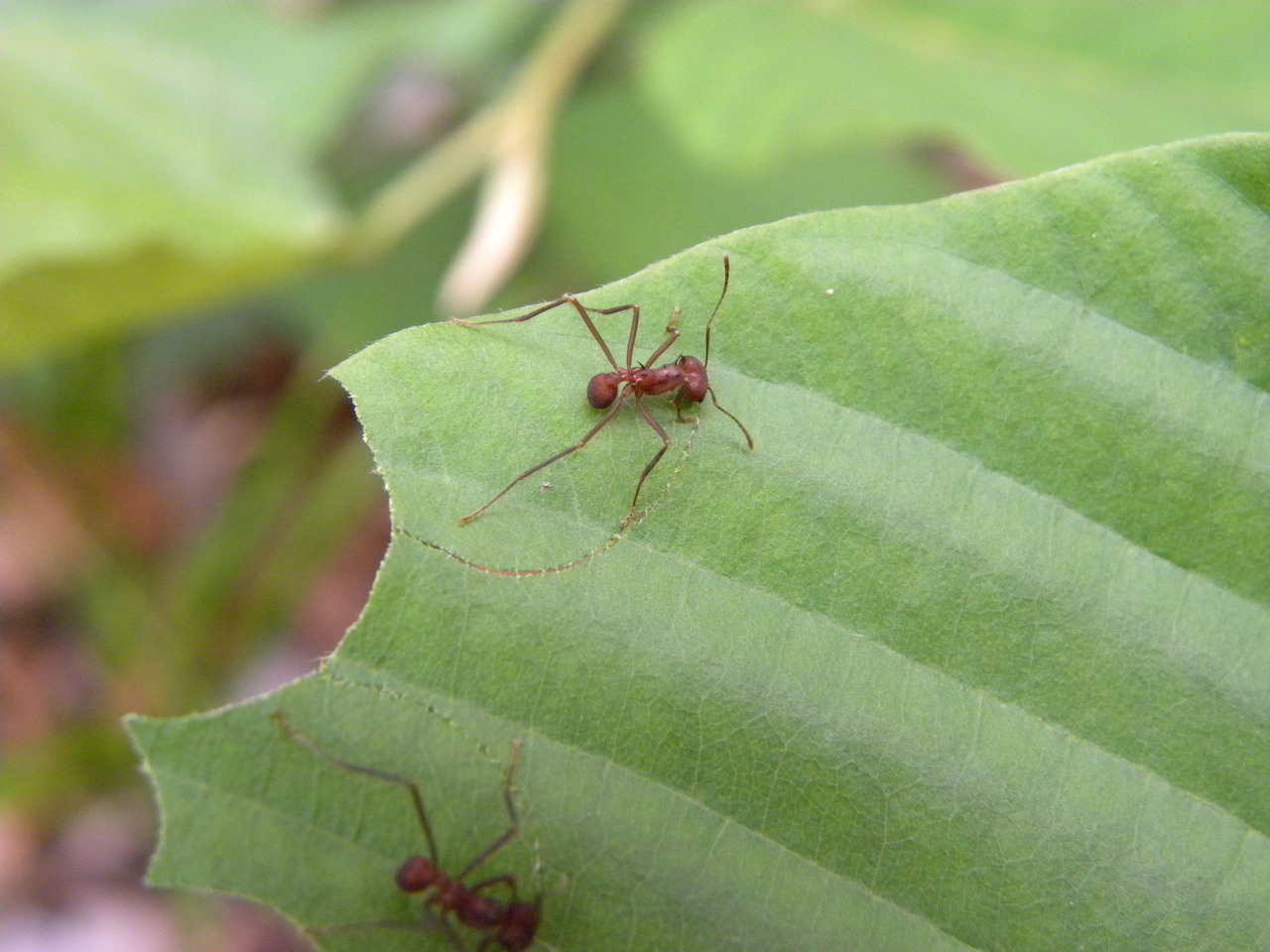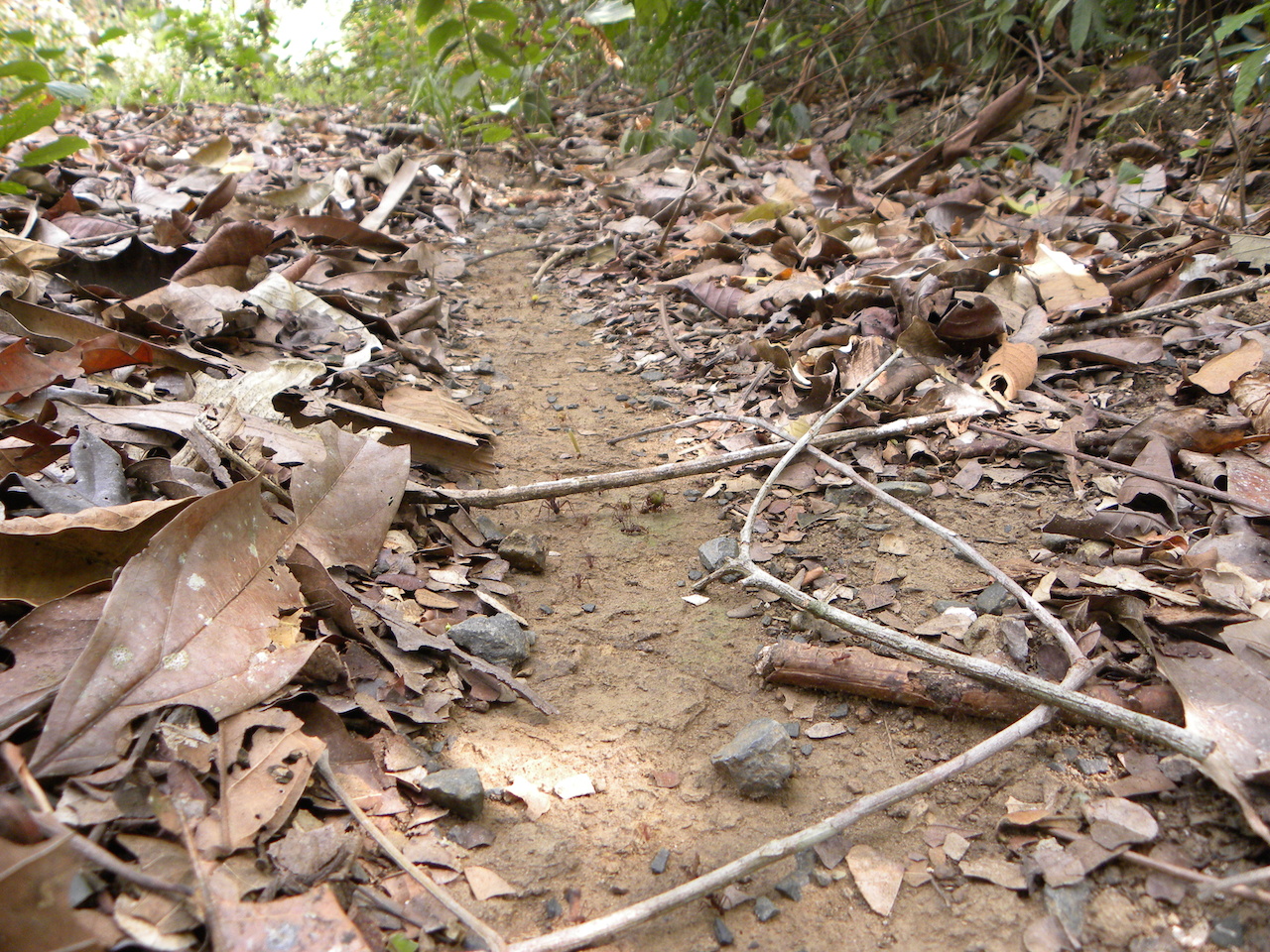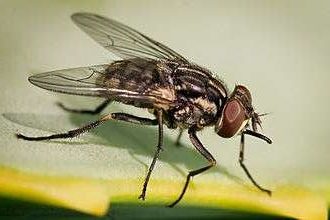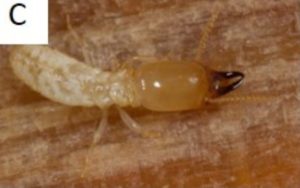The species of ants known as “mushroom ants” or “leafcutters” belong mainly to the genera Atta and Acromyrmex (family Formicidae and subfamily Myrmicinae).
The species of these two genera have the particularity of feeding on a fungus (Basidiomycete of the family Lepiotaceae) that they grow on a substrate of plant matter. To maintain this substrate, ants collect pieces of leaves or flowers in the forest and then transport them to the anthill.
I) Biography of ants of the genus Atta
The genus Atta, consisting of 15 species, occurs mainly in neotropical wetland habitats (savanna forests) of the New World (Central and South America). However, some species have adapted to less favourable climates and environments, such as A. mexicana encountered in the deserts of Mexico and southern Arizona and A. texana which can only be observed in the semi-temperate regions of Texas and Louisiana.
Species A. cephalotes and A. sexdens are both the best known and the most widely distributed. They develop in a wide variety of habitats, from tropical forests to regions degraded by human activities in Central America to the south of the continent.
Two species I had the chance to observe during my research missions in Panama and French Guiana. For more information, read these articles: Smithsonian Tropical Research Institute and Nururgues Station.
II) Social organization
Ants Atta present one of the highest degrees of complexity of social organization observed in insects.
The organization of the colony is based, as in most ants, on the model of a queen (the only individual with the capacity to lay) and of many workers (sterile females from the queen). When colonies are mature after several years of existence, winged individuals, male and female, appear, whose role is to found new colonies.

Reine : the queen Atta, with a size exceeding 2cm, is one of the largest of all ant species (see photo 1). The new queens leave their colonies to swarm and breed in the air. Once fertilization is completed, they are buried in the soil where the foundation of a new colony will begin. Throughout her life, a queen can lay eggs and thus generate millions of workers.
Works : workers of the genus Atta have the particularity of being strongly polymorphic : there are ants of different sizes with specific functions within the colony. It has been counted nearly 20 distinct tasks in a colony of Atta.
Women workers are grouped into 3 groups, also called castes (see photo 2) :
-
- les minors (2-5mm) cultivate the fungus, take care of brood (feeding and care) and nest cleaning
- les médias (5-10mm) are involved in the harvesting of plant matter and in the construction and renovation of ants
The species of ants known as “mushroom ants” or “leafcutters” belong mainly to the genera Atta and Acromyrmex (family Formicidae and subfamily Myrmicinae).
The species of these two genera have the particularity of feeding on a fungus (Basidiomycete of the family Lepiotaceae) that they grow on a substrate of plant matter. To maintain this substrate, ants collect pieces of leaves or flowers in the forest and then transport them to the anthill.
I) Biography of ants of the genus Atta
The genus Atta, consisting of 15 species, occurs mainly in neotropical wetland habitats (savanna forests) of the New World (Central and South America). However, some species have adapted to less favourable climates and environments, such as A. mexicana encountered in the deserts of Mexico and southern Arizona and A. texana which can only be observed in the semi-temperate regions of Texas and Louisiana.
Species A. cephalotes and A. sexdens are both the best known and the most widely distributed. They develop in a wide variety of habitats, from tropical forests to regions degraded by human activities in Central America to the south of the continent.
Two species I had the chance to observe during my research missions in Panama and French Guiana. For more information, read these articles: Smithsonian Tropical Research Institute and Nururgues Station.
II) Social organization
Ants Atta present one of the highest degrees of complexity of social organization observed in insects.
The organization of the colony is based, as in most ants, on the model of a queen (the only individual with the capacity to lay) and of many workers (sterile females from the queen). When colonies are mature after several years of existence, winged individuals, male and female, appear, whose role is to found new colonies.

Reine : the queen Atta, with a size exceeding 2cm, is one of the largest of all ant species (see photo 1). The new queens leave their colonies to swarm and breed in the air. Once fertilization is completed, they are buried in the soil where the foundation of a new colony will begin. Throughout her life, a queen can lay eggs and thus generate millions of workers.
Works : workers of the genus Atta have the particularity of being strongly polymorphic : there are ants of different sizes with specific functions within the colony. It has been counted nearly 20 distinct tasks in a colony of Atta.
Women workers are grouped into 3 groups, also called castes (see photo 2) :
-
-
- les minors (2-5mm) cultivate the fungus, take care of brood (feeding and care) and nest cleaning
- les médias (5-10mm) are involved in the harvesting of plant matter and in the construction and renovation of ants
- les majors (10-15mm), also called soldiers, play the role of sentinels in and outside the anthill. They usually post themselves on supply routes, ready to repel any intruders. They are easily recognizable by their particular morphology: an imposing and broad head and large mandibles. The majors are about 200 times heavier than the minors, with a head 8 times wider (see photo 2).
-

III) Nest structure and function
The nest, built in the ground, has a complex architecture adapted to the control of an environment favourable to the development of the fungus (temperature and humidity). The structure includes several chambers (from 10 to 25cm in diameter) housing the fungus, interconnected by a complex network of galleries (see video below). The particular configuration of these allows a renewal of the air inside the nest by a passive ventilation system, where the gases released by the degradation of the plant matter by the fungus are evacuated and replaced by fresh air.
When climatic and environmental conditions are less favourable (drought, high humidity, flooding), the colony is able to react by adopting the nest configuration: opening/closing of ventilation ducts, movement of mushrooms in chambers either deep, or below the soil surface…etc.
Nests that shelter several million individuals can reach more than 6m deep and require the contribution of several kilos of vegetation per day.
IV) Reproduction of the colony
Production usually starts at the beginning of the rainy season.
At this time, the young queens and the males (winged) are ready to leave their nest for a nuptial flight where the queens are fertilized by one or more males from nearby colonies. The spermatozoa, stored in the spermathèque (male gamete storage organ), are used throughout the life of the queen, nearly 20 years!
Once mating is complete, the queen falls to the ground, loses her wings by autotomy (ability to lose a body part voluntarily) and dig a hole. The fate of males is worse: they die just after reproduction.
Well installed in its cavity, the queen can start the process of foundation of her colony : culture of the fungus and laying of the first eggs. The fungus comes from a piece of her old colony that she kept in a specific crop and grows from her faecal secretions. The first larvae are fed by nutrient-rich eggs.
With the appearance of the first workers, the colony’s activity, which developed slowly the first year, grew very rapidly to reach maturity after 5 years.
V) Furging and mushroom substrate selection
caption id=”attachment_516″ align=”alignright” width=”280″] Photo 3 : Media worker of the genus Attacant cutting a piece of sheet (Source : Panama – ©Photo B. GILLES[/caption]
Photo 3 : Media worker of the genus Attacant cutting a piece of sheet (Source : Panama – ©Photo B. GILLES[/caption]
The mushroom culture requires a substrate made of vegetable matter. The workers must collect pieces of leaves (or flowers) and transport them to the anthill: this is the”fouragement” (photo 3).
To provide a quality substrate for the fungus, a plant resource selection mechanism is put in place. The principle consists in emitting a specific pheromone (molecules emitted into the environment causing a physiological or behavioural modification in the individual who receives it), via a specific gland (the old venom gland whose role has been diverted during evolution), when a worker is in the presence of a satisfactory resource. This pheromone attracts other workers to the site, thus increasing pheromone concentration, amplifying the phenomenon. When the number of workers moving back and forth between the resource and the nest becomes large, the path is cleared of any obstacles to gain efficiency, time and therefore save energy. Tens of thousands of ants can travel several hundred metres through the forest floor (see photo 4 and video below).
caption id=”attachment_524″ align=”alignleft” width=”320″] Photo 4 : Trail of passage, cleaned by Atta workers, connecting the nest to areas of felling (Source : Panama – ©Photo B. GILLES)[/caption]
Photo 4 : Trail of passage, cleaned by Atta workers, connecting the nest to areas of felling (Source : Panama – ©Photo B. GILLES)[/caption]
Video by Benoît GILLES (Panama)
Video at the origin of an article published on the website of sciencesetavenirs, find the here.
VI) Substrate fabrication, structure and function
The plant fragments, upon their arrival in the mushroom chambers, undergo a series of manipulation by the miner workers. They are crushed, macerated with specific enzymes to eliminate all undesirable micro-organisms then deposited on the substrate already present and fertilized by spores (reproductive cells in fungi and ferns) found in faecal residues.
The old substrate is removed and eliminated from the colony in a specific and remote site (see video below).
Video by Benoît GILLES (Panama)
The substrate on which the fungus grows is sponge-like in texture and about 10-25cm in diameter. Its structure is composed of more or less large cells and invaginations (see photo 5).
The mycelium of the fungus (vegetative part), white in color, is rich in nutrients and constitutes the only food resource of ants ( see photo 6).


VII) Symbiotic relationships
The mushroom culture requires a substrate made of vegetable matter. The workers must collect pieces of leaves (or flowers) and transport them to the anthill: this is the”fouragement” (photo 3).
To provide a quality substrate for the fungus, a plant resource selection mechanism is put in place. The principle consists in emitting a specific pheromone (molecules emitted into the environment causing a physiological or behavioural modification in the individual who receives it), via a specific gland (the old venom gland whose role has been diverted during evolution), when a worker is in the presence of a satisfactory resource. This pheromone attracts other workers to the site, thus increasing pheromone concentration, amplifying the phenomenon. When the number of workers moving back and forth between the resource and the nest becomes large, the path is cleared of any obstacles to gain efficiency, time and therefore save energy. Tens of thousands of ants can travel several hundred metres through the forest floor (see photo 4 and video below).
caption id=”attachment_524″ align=”alignleft” width=”320″] Photo 4 : Trail of passage, cleaned by Atta workers, connecting the nest to areas of felling (Source : Panama – ©Photo B. GILLES)[/caption]
Photo 4 : Trail of passage, cleaned by Atta workers, connecting the nest to areas of felling (Source : Panama – ©Photo B. GILLES)[/caption]
Video by Benoît GILLES (Panama)
Video at the origin of an article published on the website of sciencesetavenirs, find the here.
VI) Substrate fabrication, structure and function
The plant fragments, upon their arrival in the mushroom chambers, undergo a series of manipulation by the miner workers. They are crushed, macerated with specific enzymes to eliminate all undesirable micro-organisms then deposited on the substrate already present and fertilized by spores (reproductive cells in fungi and ferns) found in faecal residues.
The old substrate is removed and eliminated from the colony in a specific and remote site (see video below).
Video by Benoît GILLES (Panama)
The substrate on which the fungus grows is sponge-like in texture and about 10-25cm in diameter. Its structure is composed of more or less large cells and invaginations (see photo 5).
The mycelium of the fungus (vegetative part), white in color, is rich in nutrients and constitutes the only food resource of ants ( see photo 6).


VII) Symbiotic relationships
Mushroom ants, especially those of the genus Atta, and their fungi have evolved together for nearly 20-25 million years to the point of having established a relationship of total interdependence, that is, the survival of one depends on that of the other : this relationship is also called mutualism.
The fungus offers food to ants and receives care, protection and dispersion in exchange. Evolution has thus allowed the emergence of particular morphological, physiological and genetic adaptations between the two species forcing them not to live alone (lire this article).
VIII) Ecological role
Mushroom ants, through their consumption of plant matter, are major herbivores and therefore play a beneficial role in the proper functioning of the tropical forest ecosystem.
By removing a large quantity of foliage from the canopy (up to 40% of the foliage of a tree), they allow light to reach the undergrowth, promoting the development of a more diversified low vegetation, and consequently, the appearance of greater animal and plant diversity. Moreover, their nest improves soil quality through better aeration and water penetration and contributes to enriching the soil with nutrients and organic matter.
Other tropical forest ants species to discover here Eciton and Cephalotes.
Recommendations of works on this theme:
– Les Ants : Behavior, Social Organization and Evolution (Luc Passera and Serge Aron – Edition : Canadian Science Publishing – 480 pages – January 2005)
– The world of ants (Rémy Chauvin – Edition du Rocher – 285 pages – October 2, 2003)
– The extraordinary world of ants (Luc Passera – Edition : Fayard – 235 pages – March 13, 2008)
– Ant Ecology (Catherine Parr ; Kirsti Abbott & Lori Lach – Edition : Oxford University press – 2010)
– Mutualism : Ants and their Insect Partners (Bernhard Stadler & Tony Dixon – Edition : Cambridge University Press – 248 pages – April 7, 2008)
– The Leafcutter Ants – Civilization by Instinct (Bert Hölldobler & Edward O’Wilson – Edition W. W. Norton & Company – 192 pages – 26 octobre 2010)
– The Lives of Ants (Laurent keller & Elisabeth Gordon – Edition OUP Oxford – 273 pages – 26 février 2009)





